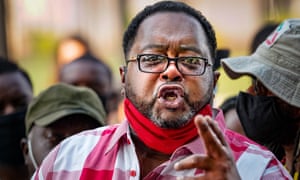
"Donald Trump has incited racist fears since he came down the gold escalator in 2015 to announce his presidential campaign. He had peaceful protesters gassed and deployed camouflaged troops to Portland, Ore., to grab protesters off the street without probable cause. He has used pictures of mayhem and violence (either from scenes playing out under his own administration or from foreign events) to instill fear in White Americans. He vowed to keep suburbs (read: White suburbs) safe from integrated housing (read: Black people). He encouraged police not to be “too nice” in handling suspects. He denies systemic racism and instead paints all protesters as anarchists, socialists and violent extremists. He has refused to condemn police officers who kill unarmed Black men and women or White armed groups engaged in violence. He invited to the Republican National Convention a couple charged with a felony for brandishing weapons at Black Lives Matter marchers. President Trump’s senior adviser Kellyanne Conway confesses the more violence in the streets, the better for him.
This phenomenon — reveling in violence from racial divisions they stoke — is part of the white supremacist playbook, specifically the phenomenon known as “accelerationism.” The Brookings Institution reports:
Some white supremacists already see the riots and broader polarization as vindication of this idea, and law enforcement and civil society activists concerned about the growth of extremism should watch to see if this idea takes further hold within white supremacist groups and organizations in the coming weeks and months.Accelerationism is the idea that white supremacists should try to increase civil disorder — accelerate it — in order to foster polarization that will tear apart the current political order. … Accelerationists hope to set off a series of chain reactions, with violence fomenting violence, and in the ensuing cycle more and more people join the fray. When confronted with extremes, so the theory goes, those in the middle will be forced off the fence and go to the side of the white supremacists.
Trump amplifies White fears. Brookings explains: “His efforts to claim that the legitimate protesters are all Antifa, blame ‘liberal Governors and Mayors’ for the unrest, and declare that ‘when the looting starts, the shooting starts’ all exacerbate tensions. Such statements are likely to provoke strong and divergent reactions from across the political spectrum rather than bring Americans together in outrage over George Floyd’s murder and the need to reject violence in favor of genuine reform.”
Republican elected officials feel comfortable reverting to the Southern Strategy, portraying themselves as the only thing standing between White people and violent Black people. It is a tune they have been singing since 1968.
Naturally then, the news media is holding Trump accountable for violence, insisting that he condemn police excesses and … no, that is not happening. Instead, they amplify Trump’s demand that Democratic presidential nominee Joe Biden do something about the violence. Biden’s weak-kneed supporters (playing into Trump’s hands) blame Biden for not denouncing violence — which Biden has repeatedly done. That in turn generates a spate of “Democrats worried violence hurts Biden” articles. The media focus on the same few incidents of violence drowns out reports (mostly in print, rarely on TV news) explaining White instigators’ role in these events. (When the role of White provocateurs does make the news, there is rarely video to accompany the brief reference to White agitators.) And you wonder how Trump gets away with rabid race-baiting?
A few Democrats have figured out what is going on. Appearing on CNN, House Intelligence Committee Chairman Rep. Adam B. Schiff (D-Calif.) observed, “They believe the violence is helpful to them. And the president is only motivated by one thing: ‘What is in it for him?’ He sees this violence — and his ability to agitate more of it — as useful to his campaign.” He added, “What it does to the country, the loss of life, he doesn’t care.”
Biden is now planning to travel on Monday (not clear where he will go) to — again — denounce the violence. But he should also go on offense. Trump incites violence. Trump encourages vigilantism. Trump refuses to acknowledge that slogans such as Blue Lives Matter can encourage vigilantes. (The White suspect who allegedly killed two people in Kenosha, Wis., apparently attended a Trump rally and brandished the Blue Lives Matter slogan.) Biden should demand Trump denounce shootings of unarmed Black men, stop Republican obstruction to police reform, cease veneration of symbols of white supremacy such as the Confederate flag and decry White armed groups.
Democrats will not win by cowering in fear that Trump will blame them for the violence he provoked. They win by making the case that Trump has made America more violent and increased racial tension for his own political benefit."






/https%3A%2F%2Fstatic01.nyt.com%2Fimages%2F2020%2F08%2F28%2Frealestate%2F28appraisals%2Fmerlin_175358394_da819689-1257-4ab4-b423-111b14e4cef9-articleLarge.jpg%3Fquality%3D75%26auto%3Dwebp%26disable%3Dupscale)
/https%3A%2F%2Fstatic01.nyt.com%2Fimages%2F2020%2F08%2F29%2Frealestate%2F00JPappraisals-print%2Fmerlin_175373454_ffbdb329-7b61-47f1-acf5-73da2e02dd5c-articleLarge.jpg%3Fquality%3D75%26auto%3Dwebp%26disable%3Dupscale)
/https%3A%2F%2Fstatic01.nyt.com%2Fimages%2F2020%2F08%2F29%2Fopinion%2F29football%2F29football-articleLarge.jpg%3Fquality%3D75%26auto%3Dwebp%26disable%3Dupscale)
